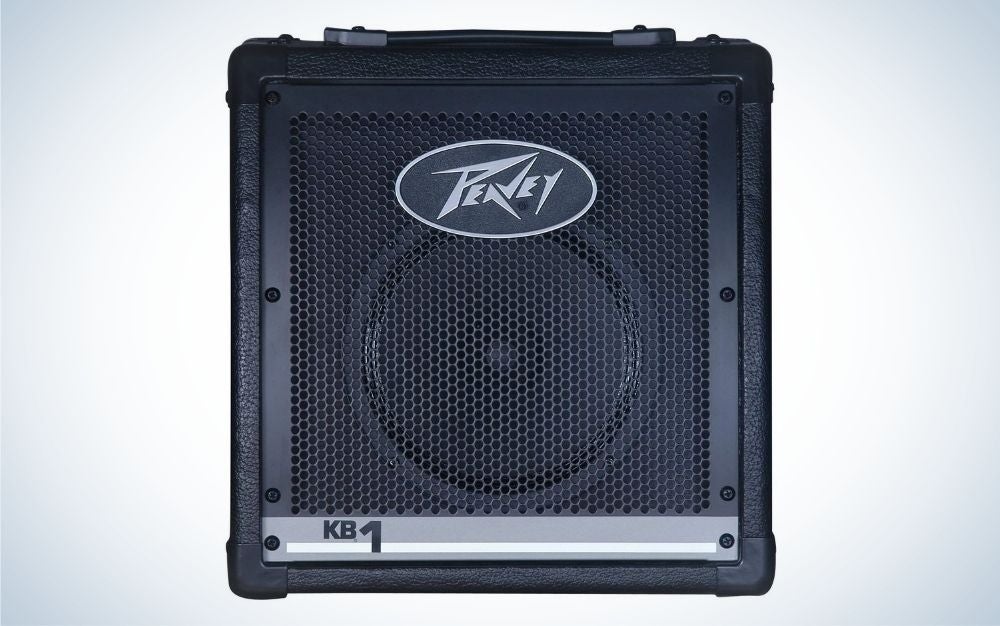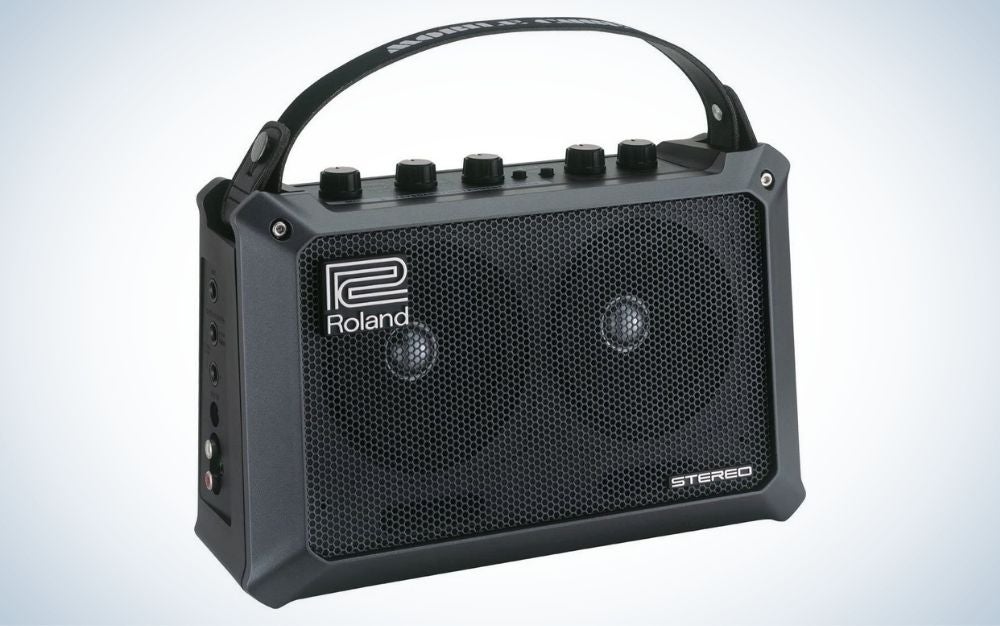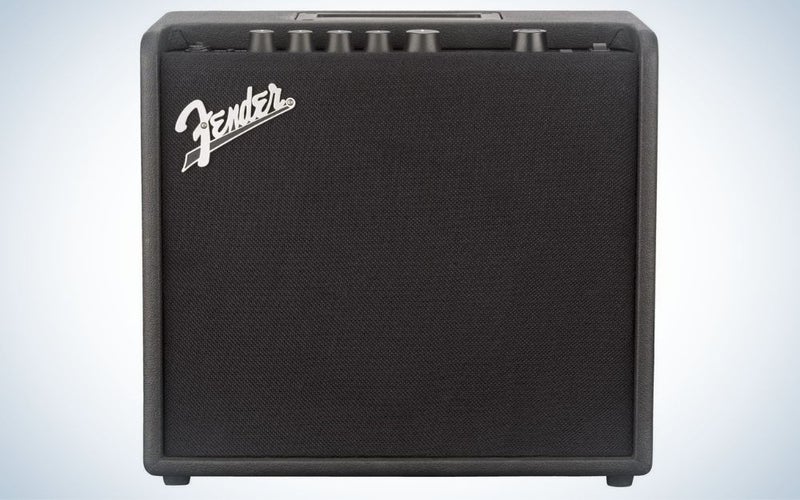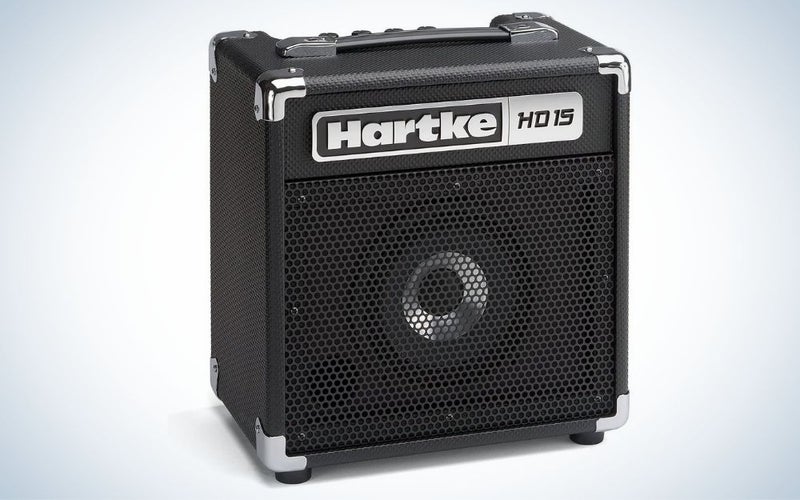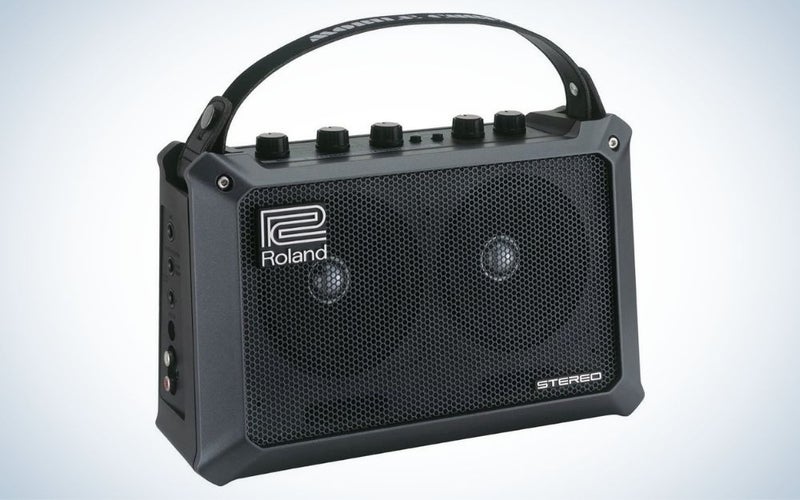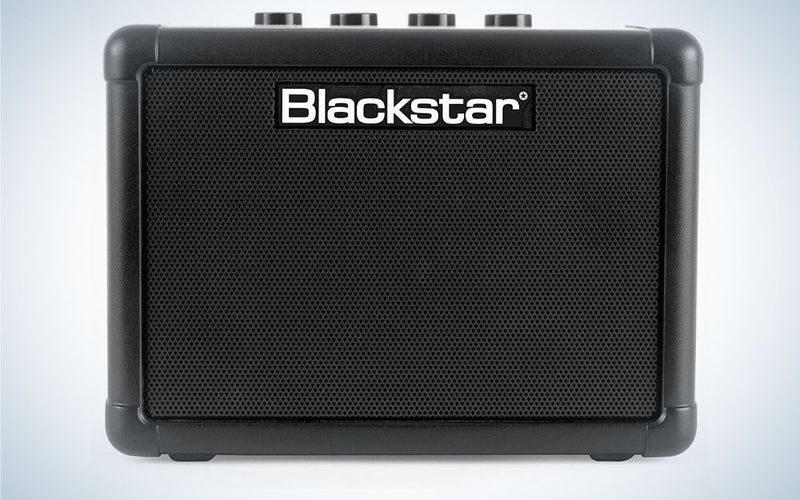We may earn revenue from the products available on this page and participate in affiliate programs. Learn more ›
You just bought an instrument, and you want to become intimately familiar with the kind of music you can make and break with it—which is where a practice amp comes in. Wanting to learn your instrument doesn’t mean your roommates, loved ones, neighbors, etc., need to get to know it as well. The practice amp is a smaller, portable, quieter, and in many cases, kind and forgiving version of a traditional amp. This is your essential tool for learning, whether you’re a beginner or an experienced musician. Besides being less cumbersome than regular amplifiers, many practice amps include unique features like analog inputs for jamming along to backing tracks and headphone outputs for completely silent play. Because they’re also significantly lower in wattage than traditional amplifiers, practice amps consume less power, making them an all-around better choice for everyday playing purposes and portable use like busking and performing in small spaces. If you need a flexible solution for playing bass, keyboard, guitar, and other amplified instruments that’s less likely to generate noise complaints, here are our picks for the best practice amps to sharpen big riffs in small spaces.
- Best for guitars: Fender Mustang LT-25 Digital Guitar Amplifier
- Best for bass: Hartke HD15 Bass Combo Amp
- Best for keyboards: Peavey KB-1 Keyboard Amp
- Best small practice amp: Roland Mobile Cube Stereo Amplifier
- Best under $100: Blackstar FLY3 Amplifier
How we picked the best practice amps
Size is an important factor to consider when buying an amplifier for playing a musical instrument. Because smaller speakers are generally quiet and struggle to reproduce low frequencies, the best practice amps have speakers from between 6 to 8 inches for producing well-rounded sound with fewer compromises. Most of the amps on our list fall within this range with the exception of the Roland Mobile Cube and the Blackstar FLY3, which are mobile amps with speakers that measure 4 inches and 3 inches, respectively.
Because practice amps are best for learning music or playing along with backing tracks, each item on our list has an auxiliary input for an MP3 player or music device, as well as a headphone output for silent practice. Some models like the Peavey KB-1 and the Fender Mustang LT-1 use a single 1/4-inch or 1/8-inch jack for auxiliary input, while others like the Roland Mobile Cube provide dedicated RCA inputs for playback systems like DJ equipment and samplers. Just add a budget guitar and you’re ready to go.
Best for guitars: Fender Mustang LT-25 Digital Guitar Amplifier
Fender
Why it made the cut: The Mustang LT-25 includes over two dozen onboard guitar tone presets in a small and stylish package, making it one of the most versatile and best guitar practice amps available.
Specs
- Wattage: 25 watts
- Weight: 14.9 pounds
- Inputs: One 1/4-inch, one 1/8-inch
| Pros: | Cons: |
Fender has a far-reaching, far-deserved reputation in the music business for manufacturing legendary guitars and tube amplifiers. Now the company has distilled a bit of this history into the highly versatile Mustang LT-25. This digital practice amp includes 30 modeling presets right out of the box—including clean tones and overdrive effects, as well as delay, reverb, and modulation options—allowing users to achieve a wide palette of tones without extra gear. All presets and onboard effects are accessed via a simple knob on the top panel next to an auxiliary input, headphone output, and a 1.8-inch color display that clearly shows the number and name of the current amp setting. Other top-panel functions include an onboard guitar tuner, which is convenient for making adjustments on the fly without interrupting your creative flow. Compared to the most basic guitar practice amps on the market, the Mustang LT-25’s ability to accurately model a variety of guitar amp tones makes it a good one-stop option for playing different styles of music without the need to bring your own effects.
The flipside to this versatility is that the LT-25 lacks granular control over the sound itself. While users can toggle through effects and amp models, the LT-25 only includes a simple two-band equalizer on top. In this way, users can’t really shape and custom-tailor their sound beyond what the amp offers by default. It also includes a footswitch jack but doesn’t include a footswitch itself, requiring users to pick up a specific model that can only toggle between presets without much customizability.
Best for bass: Hartke HD15 Bass Combo Amp
Hartke
Why it made the cut: The HD15 from Hartke does a fantastic job producing volume and lower frequencies considering its small 6.5-inch speaker.
Specs
- Wattage: 15 watts
- Weight: 16 pounds
- Inputs: One 1/4-inch, one 1/8-inch
| Pros: | Cons: |
While many small, underpowered amps can struggle to produce low frequencies due to the sheer amount of power required to move the cone, the Hartke HD15 performs well above its weight class in the low-end division. The unit is super portable, weighing in at only 16 pounds, and it features a 6.5-inch hybrid cone made of paper and aluminum, which provides an ear-pleasing combo of punchiness and smoothness not usually found in speakers of this size. A three-band equalizer (accessible via knobs on the top panel) allows users to dial in their preferred bass tones, while an 1/8-inch auxiliary input supports backing track integration and a 1/4-inch stereo headphone output provides silent play.
The HD15 can be played quietly, but it has a surprising amount of headroom for an amp of its size. This allows it to excel in most full-band rehearsal situations and hold its own alongside drum sets and guitar amps. Despite this, it still lacks the power required for producing the rumble and shake of the deepest frequencies, so it’s not great for projecting in performance settings or large venues. It also lacks a direct output that would allow it to be integrated with a PA or sound system, so this is a unit that’s better suited for rehearsals and limited performances in close quarters.
Best for keyboards: Peavey KB-1 Keyboard Amp
Peavey
Why it made the cut: An extended frequency range of 50 Hz to 10 kHz and dual 1/4-inch inputs make the KB-1 a good portable option for amplifying keyboards, electronic drum kits, backing equipment, and more.
Specs
- Wattage: 20 watts
- Weight: 18.6 pounds
- Inputs: Two 1/4-inch
| Pros: | Cons: |
This keyboard practice amp is a conveniently sized 20-watt amp featuring a single 8-inch driver. Thanks to its two 1/4-inch inputs and built-in mixer, it’s a great choice for amplifying multiple instruments at a time. Its extended frequency response is ideal for the varied sounds of electronic drum kits, samplers, keyboards, and other instruments. While it lacks onboard effects and custom-tailored tones, it can even perform honorably for guitarists and bassists who use a lot of pedalboards or outboard effects.
Each channel features its own two-band equalizer for general custom-shaping of the final sound, but they lack a midrange adjustment option. If you’ll be using the KB-1 for general duties and PA functionality, you may want to consider using it alongside a small mixer with its own EQ, like the Q1202USB from Behringer. The KB-1 also lacks a dedicated auxiliary input unlike other options on this list, but one of its two inputs can be harnessed for this purpose.
Best small practice amp: Roland Mobile Cube Stereo Amplifier
Roland
Why it made the cut: The Roland Mobile Cube is a portable stereo amplifier with optional battery power and a plethora of inputs, making it ideal as a mobile performing amp and a home studio centerpiece.
Specs
- Wattage: 5 watts
- Weight: 5.56 pounds
- Inputs: Two 1/4-inch, one 1/8-inch, two RCA
| Pros: | Cons: |
Measuring at less than 1-foot wide and only 7-inches tall, the Roland Mobile Cube is the best small practice amp and flexible enough to accommodate almost any type of audio input you throw at it. Dual RCA inputs allow for amplification of backing tracks and other stereo devices and dedicated microphone and instrument inputs offer their own volume controls for simultaneous mixing. This amp’s ability to mix three signals at once makes it a good choice for singer-songwriters and other artists who use microphones, instruments, and backing tracks at the same time.
A knob on the top panel grants users access to switchable EQ presets tailored to the needs of specific sources, including acoustic guitar and keyboard. This is a unique and convenient feature that spares users the need to fine-tune their own EQ, but some may dislike this lack of granular control over the amp’s sound. While the Mobile Cube is very compact and capable of decent projecting in small indoor spaces, its two 4-inch speakers don’t get quite loud enough to be heard over instruments like drum sets, making it suboptimal for full-band setups. The ability to run via either DC power or six AA batteries does make it a highly portable option for solo or even duo performances, however.
Best practice amp under $100: Blackstar FLY3 Amplifier
Blackstar
Why it made the cut: The FLY3 from Blackstar is an intriguing take on the traditional portable practice amp, combining onboard effects, auxiliary I/O, and external speaker compatibility within minuscule dimensions.
Specs
- Wattage: 3 watts
- Weight: 2 pounds
- Inputs: One 1/4-inch, one 1/8-inch
| Pros: | Cons: |
This miniature amp from Blackstar is both portable and expandable and the best practice amp under $100, making it a good option for users who travel and require flexibility from their music rig. It receives power via an AC adapter (sold separately) or six AA batteries and it hosts one single instrument input, an auxiliary input, and a headphone output. In spite of lacking any dimension greater than 8 inches, the amplifier also features knobs for tone control and delay effects control, as well as a dedicated button for switching between clean and overdriven tones.
While the FLY3 isn’t particularly loud due to its small size and low wattage, users looking to get more volume out of the amp can connect a separately sold Blackstar external cabinet, increasing the amp’s power from 3 watts to 6 watts and doubling the number of speakers. This option also causes the two speakers to function in true stereo mode, adding more dimensionality to the amplification of stereo line-in sources.
This low volume is not ideal for playing music with other people or performing in any capacity, but the FLY3 is excellent for quieter practice purposes and is a good option for guitarists working on music while traveling or living in a small place. Keep in mind that its small speaker and overall sound are tailored for guitar, so electric bass, electronic drum kit, and keyboard risk sounding thin.
Things to consider before buying a practice amp
When selecting the best practice amp for your needs, the first and most important consideration is what you’re looking to amplify, as amps of different sizes compliment different types of instruments. For example, guitars and vocals occupy a specific frequency range above 200 Hz that doesn’t require bulky speakers, but achieving sufficient low-frequency playback for bass, keyboards, and DJ equipment requires relatively larger speakers and higher wattage. In the case of low-frequency-capable practice amps, manufacturers typically compromise and use slightly larger speakers in the 8-inch range, which provide a reasonable amount of low-end without being too heavy.
Headphone outputs and audio playback compatibility are also key features to look for when purchasing a practice amp. While most studio amplifiers and large instrument amplifiers lack a dedicated auxiliary input, the best practice amps allow musicians to amplify stereo audio sources for playing along with backing tracks. This functionality is a great practice tool, but it’s also convenient for street performers and ensembles who rely on backing tracks for simplifying their setup.
If you’re looking for a mobile solution, battery power is another feature to consider when shopping for a practice amp. The fact that the Roland Mobile Cube and the Blackstar FLY3 are the only amplifiers on our list that run on batteries is no coincidence; they’re portable and relatively small, so they don’t require a lot of power to function. On the other hand, lower-wattage amplifiers like these aren’t capable of producing the higher volumes required to be heard over a full band, so they’re better suited to mobile practicing or solo performances.
FAQs
Q: How many watts should a practice amp be?
With an increase in wattage comes an increase in both power and bulk, so compromise is in order when searching for the most useful practice amp design. The best practice amps for guitar and low-frequency instruments like bass and keyboard fall within the 15- to 25-watt range and are generally suited for rehearsing with other people. Smaller practice amps excel at portability at the expense of power and dynamic range, and these usually range between 3 watts and 5 watts.
Q: How much does a practice amp cost?
Practice amps cover a wide range of price points; some like the Blackstar FLY3 cost less than $100, while models like the Fender Mustang LT-25 hover around the average of $200. Musicians who want the absolute best might even consider a tube amp like the Fender Champ, which stretches to over $1,000.
Q: Are higher wattage amps louder?
Loudness is affected by speaker efficiency as well as wattage, so while higher wattage generally translates to more volume, the reality is slightly more complex. Additionally, volume and wattage have an exponential relationship; doubling the volume of an amplifier requires wattage to be multiplied by a factor of 10. So, no, buying an amp with a higher wattage doesn’t not guarantee you a higher volume.
The final word on buying the best practice amps
The best practice amps for guitar, bass, keyboard, and other instruments are portable alternatives to bulkier options, making them suited for rehearsal use and quiet performances. When selecting a practice amp, remember that ones with a higher wattage are heavier and more capable of producing useful levels of low frequencies, making them better suited for band rehearsals, while smaller amps have lower wattages and are better suited for mobile performances and playing at home. Whichever one you choose, these practice amps will rise to the occasion and deliver a full, high-quality tone whether you’re jamming at home or performing in a small space.


